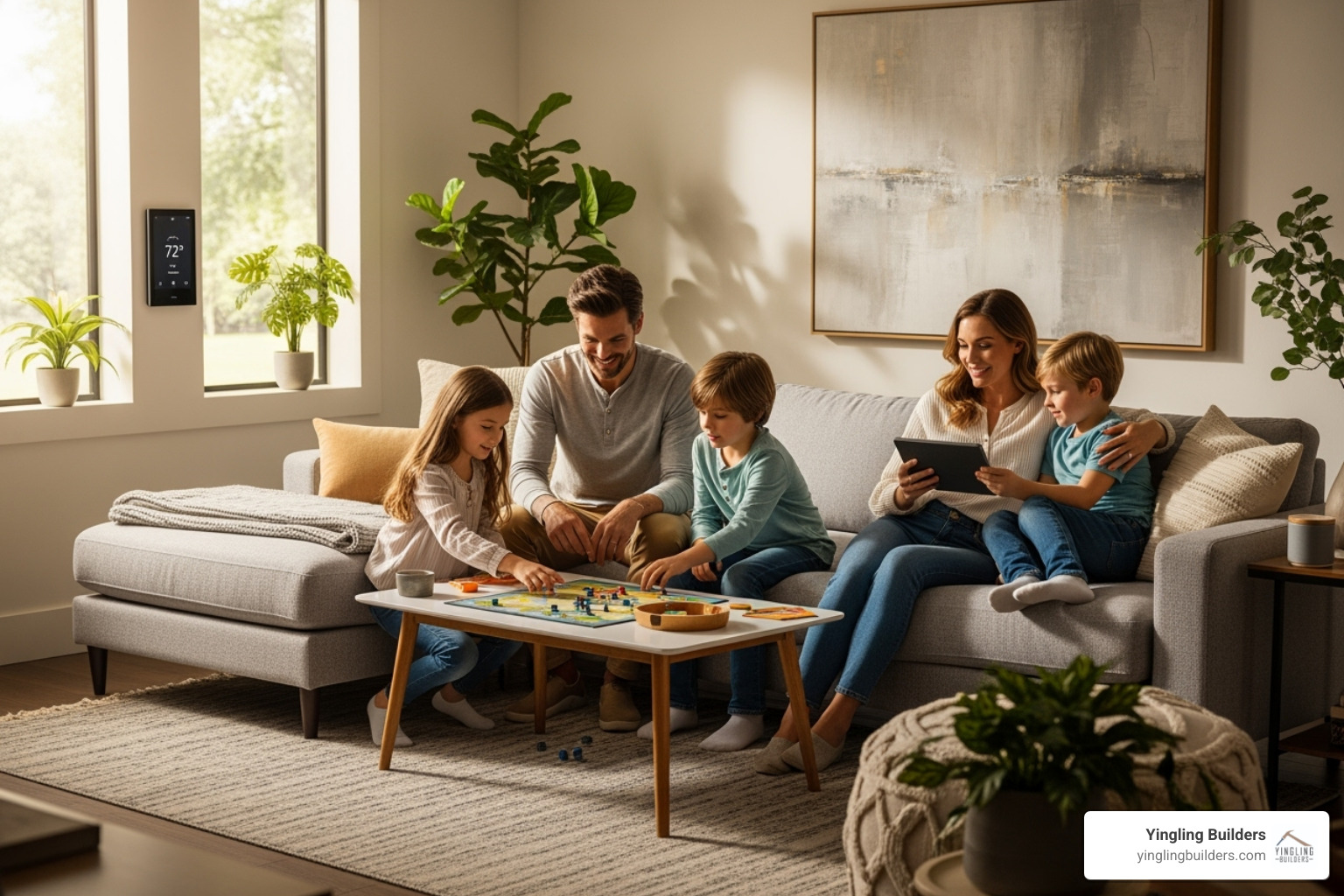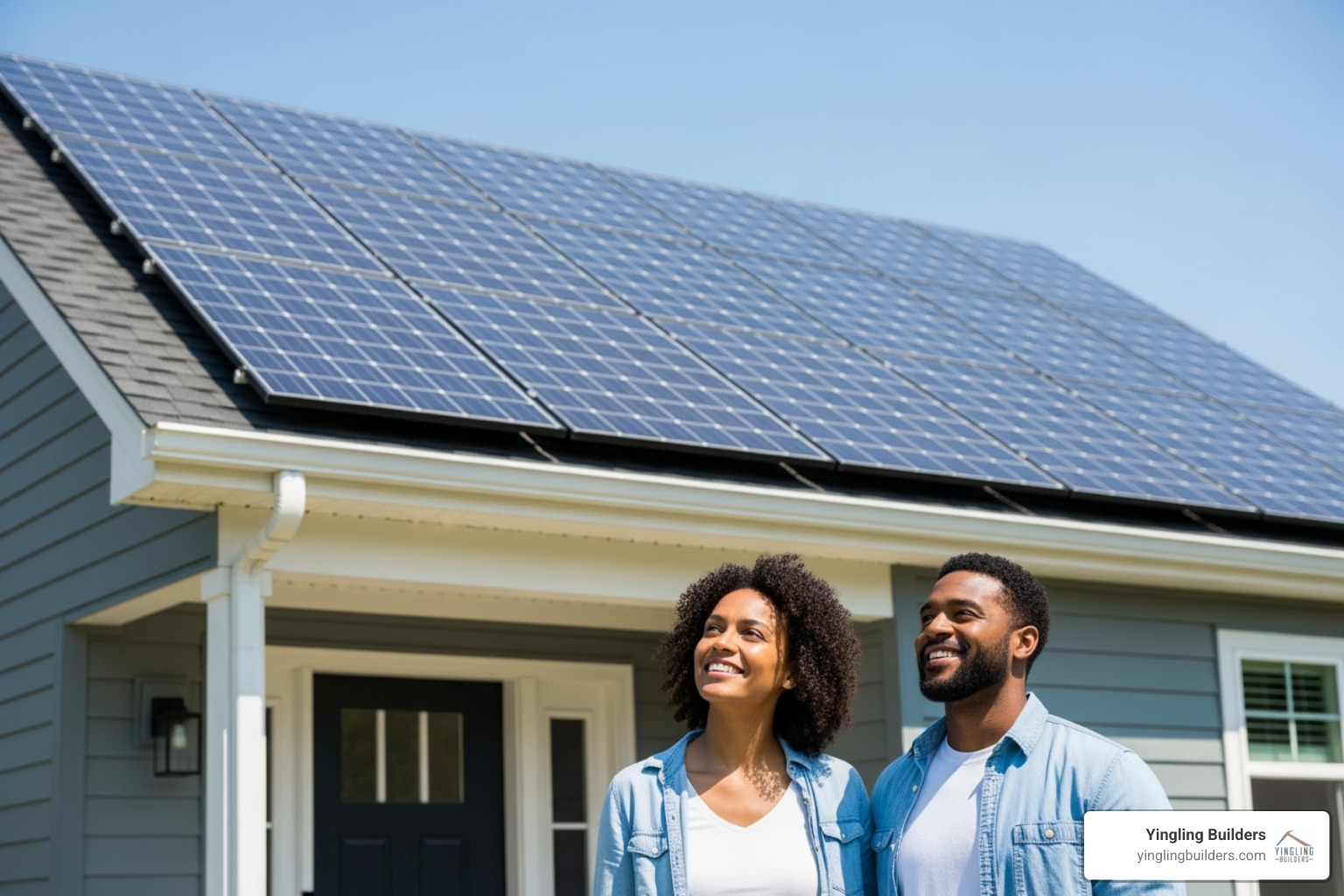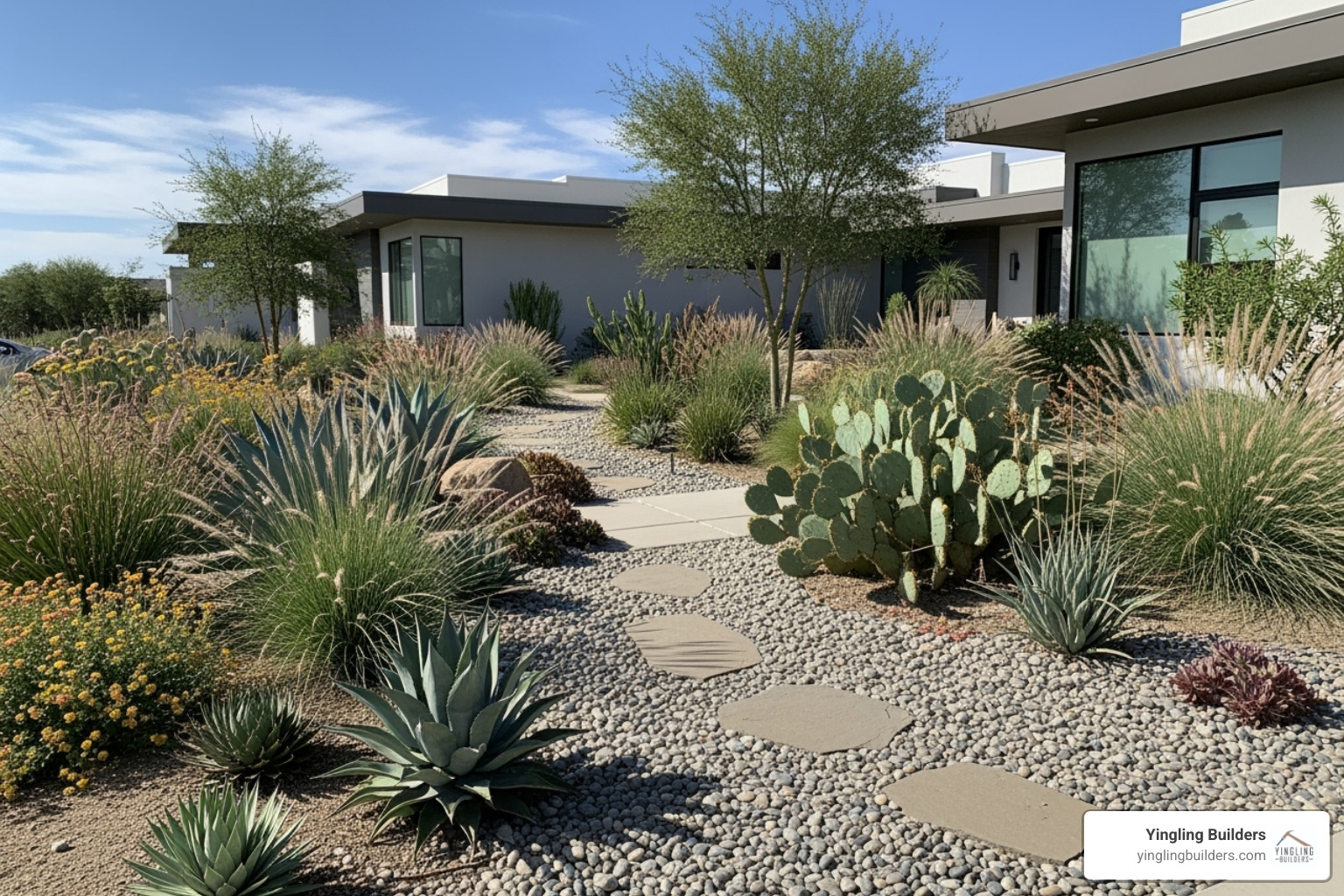Why Modern Homes Need More Than Basic Building Codes
Energy efficient home features are essential components for any modern home, delivering significant comfort, savings, and long-term value. By integrating these features, a home can use far less energy while providing superior comfort and indoor air quality.
Key energy-efficient features include:
- High-performance insulation and air sealing
- ENERGY STAR certified appliances and HVAC
- Smart thermostats and home automation
- High-performance windows with low-E coatings
- Efficient water heating (tankless or heat pump)
- LED lighting
- Ventilation with heat recovery systems
The numbers tell the story. ENERGY STAR certified homes are at least 10% more energy efficient than homes built to code and command 2% to 8% higher resale values. While heating and cooling alone account for 48% of home energy use, a comprehensive approach that addresses the entire home can cut total energy costs by up to 25%.
Today’s homebuyers, especially millennials who make up 37% of the market, prioritize efficiency for its financial, health, and comfort benefits. They seek resilient, comfortable homes that protect against rising energy costs and power outages.
Why Investing in Efficiency Pays Off
Choosing a home with energy efficient home features is one of the smartest investments you can make, with benefits that improve your budget, comfort, and home value.
- Utility Bill Savings: A home designed to minimize energy waste makes every dollar work harder. The Department of Energy reports that comprehensive efficiency upgrades can cut total energy costs by up to 25%. Even basic air sealing and insulation can save an average of 11% on your entire energy bill.
- Improved Comfort: Energy-efficient homes maintain steady temperatures, eliminating cold spots and stuffy rooms. Your home stays cozy in winter and cool in summer, regardless of the weather.
- Healthier Air Quality: Advanced ventilation systems filter out allergens, pollutants, and excess humidity, providing cleaner air for your family to breathe.
- Higher Property Value: Studies consistently show that efficient homes command 2% to 8% higher resale prices. This premium reflects growing buyer demand for sustainability and lower operating costs. Explore how to incorporate these features in our custom design approach.
- Outage Resilience: Well-insulated, tightly sealed homes maintain comfortable temperatures much longer during a power outage. In one study, efficient homes stayed near 60°F during a winter blackout while others dropped to near freezing.
- Environmental Benefits: Reducing your home’s energy consumption directly shrinks your carbon footprint. Today’s homebuyers, particularly millennials, seek homes that align with their values of financial savings and environmental responsibility.
Investing in energy efficiency pays you back in comfort, savings, and peace of mind.
Top 12 Energy Efficient Home Features
The most effective energy efficient home features come from a “whole-building strategy,” where every component works in harmony. A home’s performance is measured by the HERS Index—a lower score means better efficiency. A standard new home scores around 100, while an efficient home can score 70 or less, often earning the ENERGY STAR label for being at least 10% more efficient than code.
Since heating and cooling account for 48% of a home’s energy load, a comprehensive approach yields the biggest savings. Here’s how high-efficiency construction compares to standard building:
| Feature | Standard Construction | High-Efficiency Construction |
|---|---|---|
| Insulation | Code-minimum R-values, potential gaps | Exceeds code, continuous insulation, high R-values |
| Air Sealing | Basic sealing, allows drafts | Comprehensive sealing, blower-door tested |
| Windows & Doors | Single/double pane, basic frames, air leakage | Low-E, insulated frames, multi-pane, airtight |
| HVAC System | Standard efficiency furnace/AC | High-efficiency heat pump, proper sizing |
| Water Heater | Traditional tank-style | Tankless or heat pump water heater |
| Lighting | Incandescent/CFL bulbs | 100% LED lighting |
| Appliances | Standard models | ENERGY STAR certified |
| Smart Technology | Limited or none | Smart thermostat, home automation |
| Ventilation | Passive or exhaust-only | ERV/HRV, controlled fresh air |
| Roofing | Dark, heat-absorbing materials | Cool roof materials, reflective coatings |
| Site Orientation | Often overlooked | Optimized for passive solar gain/shading |
| Renewable Energy | None | Solar PV ready or installed |
Energy Efficient Home Features Inside the Walls

The most critical energy efficient home features are in the building envelope. Proper insulation can cut heating and cooling costs by up to 50%. We go beyond code minimums, often using materials like Insulated Concrete Forms (ICFs) to provide continuous R-23 insulation. This eliminates “thermal bridging”—pathways for heat to escape through wall studs.
Effective insulation requires comprehensive air sealing. Sealing gaps and cracks throughout the home can save 11% on total energy costs, according to the EPA. We also use advanced framing techniques to maximize insulation space and improve thermal performance. These foundational choices are key to long-term comfort and savings, a crucial part of your Custom Home Cost.
Windows & Doors That Work Harder
The Department of Energy estimates that 25% to 30% of heating and cooling energy is lost through windows. Modern high-performance windows prevent this with features like low-emissivity (low-E) coatings that reflect heat, multiple panes filled with inert gas like argon, and insulated frames. In our climate, triple-pane windows can make a dramatic difference. Airtight doors with quality weather-stripping are just as vital to prevent drafts. Proper installation is key to performance, a fact supported by Scientific research on window upgrades.
Smart Tech & Appliances That Slash Bills (energy efficient home features)

Once the envelope is secure, smart technology puts you in control. Smart thermostats learn your routines and can save up to 15% on heating and cooling costs. ENERGY STAR certified appliances also offer significant savings; for example, an ENERGY STAR dryer uses 20% less energy than a standard model. Using smart power strips to eliminate phantom loads from electronics in standby mode adds to the savings. Factoring these items into your plan is easy with our guide on Budgeting for a Custom Build.
Ultra-Efficient Mechanical Systems
Your HVAC and water heating systems account for roughly 67% of your home’s energy use (48% HVAC, 19% water). Heat-pump HVAC systems are a top choice because they move heat rather than creating it, using up to 50% less electricity than traditional systems. Ductless mini-splits offer zoned heating and cooling for even greater efficiency. In tightly sealed homes, Energy Recovery Ventilation (ERV) systems provide fresh air without wasting energy. For water heating, tankless or heat pump water heaters are far more efficient than traditional tanks. Proper sizing and quality installation are critical, as poor installation can reduce efficiency by up to 30%. Scientific research on heat pumps confirms their effectiveness.
Renewable & Passive Design Boosts

Some of the best energy efficient home features work passively with nature. Solar photovoltaic (PV) panels can dramatically cut energy bills and increase home value. We can design your home to be “solar-ready” or install a full system.
Passive solar design uses your home’s site orientation and window placement to capture winter sun and block summer heat. Cool roofs with reflective materials keep your attic and home cooler, reducing AC demand. Strategic landscaping, like shade trees, can cut air conditioning costs by 15% to 50%. We consider these elements from the start, as outlined in our guide on What to Consider Before Building Your Dream Home.
Water & Landscape Efficiency Features

Water efficiency is linked to energy efficiency because heating water consumes a lot of energy. WaterSense labeled fixtures are at least 20% more water-efficient than standard models without sacrificing performance. For landscaping, native and drought-resistant plants require far less water than traditional lawns, and drip irrigation minimizes waste. As mentioned, landscaping also provides energy benefits; deciduous trees on the south and west sides of a home provide summer shade and allow winter sun, cutting cooling costs by 15% to 50%.
Whole-House Systems Approach & Certifications
Truly effective energy efficient home features require systems thinking—treating the home as one integrated system. The best insulation is undermined by leaky windows, and a great HVAC system struggles in a poorly sealed house. At Yingling Builders, we ensure every component—insulation, windows, HVAC, and more—works together for maximum efficiency and comfort.
Third-party testing and certifications provide proof of this performance. These aren’t just badges; they are rigorous standards verified by professionals.
- The HERS Index is a fuel economy rating for your home; a lower score is better. A standard new home is 100, while our efficient homes can score 70 or less.
- ENERGY STAR Home certification guarantees a home is at least 10% more efficient than one built to code, verified through inspections and testing.
- LEED certification assesses overall environmental impact, including energy, materials, and water conservation.
- The Home Energy Score (1-10) from the Department of Energy offers a simple way to compare efficiency.
These certifications rely on independent verification, like blower door tests for air leakage, to ensure you get proven performance. Our commitment to a quality Process ensures we meet these standards, delivering homes that perform exceptionally.
Assessing & Upgrading an Existing Home

If you’re not building new, you can still dramatically improve your home’s efficiency. The best first step is a professional energy audit. An auditor uses tools like a blower-door test to find air leaks and thermal imaging to see where heat is escaping. The resulting report provides a prioritized roadmap for the most cost-effective upgrades.
Before starting larger projects, check for financial assistance. The DSIRE (Database of State Incentives for Renewables & Efficiency) website is a treasure map of rebates and incentives. Federal tax credits, state programs, and local utility rebates can significantly lower the cost of new insulation, windows, or HVAC systems.
Frequently Asked Questions About Energy Efficient Home Features
Homeowners often have questions when exploring energy efficient home features. Here are answers to the three most common ones.
What is an energy efficient home?
An energy-efficient home is designed as an integrated system to use significantly less energy for heating, cooling, and appliances, all while providing superior comfort. It combines high-performance materials, advanced mechanical systems, and smart technology to minimize energy waste. The result is lower utility bills, more consistent temperatures, better air quality, and a reduced environmental impact.
Which upgrade delivers the fastest payback?
For the quickest return on investment, start with these upgrades:
- LED lighting: These bulbs use up to 90% less energy than incandescent ones and last for years, offering immediate savings.
- Smart thermostats: By learning your schedule, they can cut heating and cooling costs by up to 15% and often pay for themselves in the first year.
- Air sealing and insulation: Adding insulation to an attic and sealing air leaks are affordable improvements that can save around 11% on total energy costs.
How do I know if a builder is committed to energy efficiency?
A truly committed builder will focus on a whole-house systems approach, explaining how insulation, windows, and HVAC work together. Look for builders who offer third-party certifications like ENERGY STAR or provide HERS Index ratings, as these require independent verification of performance. They should be able to explain technical details (like R-values and U-factors) and what they mean for your comfort and bills. Finally, a dedicated builder will be transparent about their process and proud to share their portfolio of high-performing homes.
Conclusion
Choosing a home with energy efficient home features is a smart decision for your family, your finances, and the future. These homes deliver lower utility bills, consistent comfort, healthier indoor air, and higher resale value. They are future-proof, providing resilience against rising energy costs and extreme weather.
At Yingling Builders, we specialize in integrating these features seamlessly, creating homes that are as high-performing as they are beautiful. We use proven, customizable plans equipped with the latest efficiency technologies.
We have the expertise to build a home that works for you, whether you’re interested in solar panels, heat pump systems, or simply a comfortable, affordable-to-run home. Ready to plan a home that’s as efficient as it is beautiful? Contact us today to discuss how these innovative features can become part of your dream home.

0 Comments